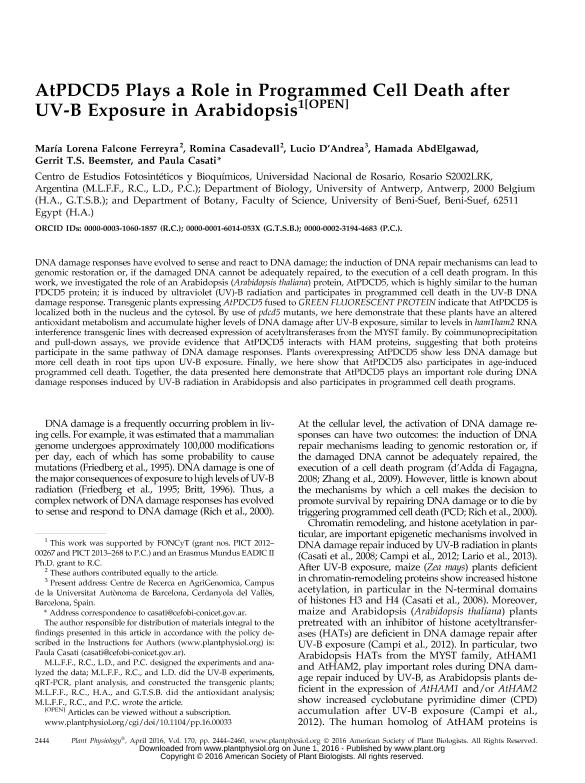Artículo
AtPDCD5 plays a role in programmed cell death after UV-B exposure in arabidopsis
Falcone Ferreyra, María Lorena ; Casadevall, Romina
; Casadevall, Romina ; D'andrea, Lucio Jesus; Abdelgawad, Hamada; Beemster, Gerrit T.S.; Casati, Paula
; D'andrea, Lucio Jesus; Abdelgawad, Hamada; Beemster, Gerrit T.S.; Casati, Paula
 ; Casadevall, Romina
; Casadevall, Romina ; D'andrea, Lucio Jesus; Abdelgawad, Hamada; Beemster, Gerrit T.S.; Casati, Paula
; D'andrea, Lucio Jesus; Abdelgawad, Hamada; Beemster, Gerrit T.S.; Casati, Paula
Fecha de publicación:
04/2016
Editorial:
American Society of Plant Biologist
Revista:
Plant Physiology
ISSN:
0032-0889
Idioma:
Inglés
Tipo de recurso:
Artículo publicado
Clasificación temática:
Resumen
DNA damage responses have evolved to sense and react to DNA damage; the induction of DNA repair mechanisms can lead to genomic restoration or, if the damaged DNA cannot be adequately repaired, to the execution of a cell death program. In this work, we investigated the role of an Arabidopsis (Arabidopsis thaliana) protein, AtPDCD5, which is highly similar to the human PDCD5 protein; it is induced by ultraviolet (UV)-B radiation and participates in programmed cell death in the UV-B DNA damage response. Transgenic plants expressing AtPDCD5 fused to GREEN FLUORESCENT PROTEIN indicate that AtPDCD5 is localized both in the nucleus and the cytosol. By use of pdcd5 mutants, we here demonstrate that these plants have an altered antioxidant metabolism and accumulate higher levels of DNA damage after UV-B exposure, similar to levels in ham1ham2 RNA interference transgenic lines with decreased expression of acetyltransferases from the MYST family. By coimmunoprecipitation and pull-down assays, we provide evidence that AtPDCD5 interacts with HAM proteins, suggesting that both proteins participate in the same pathway of DNA damage responses. Plants overexpressing AtPDCD5 show less DNA damage but more cell death in root tips upon UV-B exposure. Finally, we here show that AtPDCD5 also participates in age-induced programmed cell death. Together, the data presented here demonstrate that AtPDCD5 plays an important role during DNA damage responses induced by UV-B radiation in Arabidopsis and also participates in programmed cell death programs.
Palabras clave:
Pdcd5
,
Uv-B Radiation
,
Senescence
Archivos asociados
Licencia
Identificadores
Colecciones
Articulos(CEFOBI)
Articulos de CENTRO DE EST.FOTOSINTETICOS Y BIOQUIMICOS (I)
Articulos de CENTRO DE EST.FOTOSINTETICOS Y BIOQUIMICOS (I)
Citación
Falcone Ferreyra, María Lorena; Casadevall, Romina; D'andrea, Lucio Jesus; Abdelgawad, Hamada; Beemster, Gerrit T.S.; et al.; AtPDCD5 plays a role in programmed cell death after UV-B exposure in arabidopsis; American Society of Plant Biologist; Plant Physiology; 170; 4; 4-2016; 2444-2460
Compartir
Altmétricas



